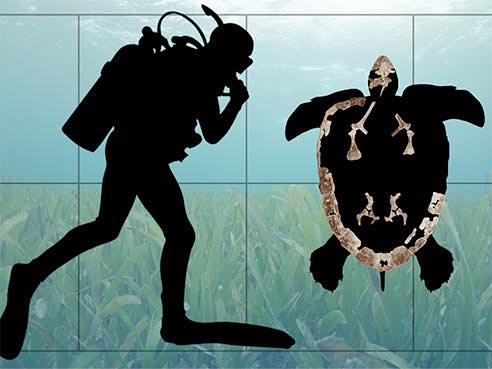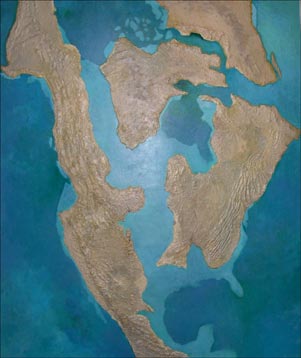Graduate Student Unlocks the Secrets of Sea Turtle Evolution
Ctenochelys acris Comes Out of its Shell
Palaeontologists have long puzzled over the origins of today’s extant species of sea turtle. Thanks to the efforts of a post-doctoral student at the University of Alabama (Birmingham, Alabama, USA), scientists have been able to confirm the existence of a marine adapted turtle representing the oldest known member of the lineage that gave rise to modern sea turtles.
In a paper published in the academic publication “The Journal of Systematic Palaeontology”, lead author Drew Gentry, has been able to identify several 80-million-year-old fossils as Ctenochelys (tee-no-key-lees) acris, thus helping to piece together the evolutionary history of sea turtles.
For models and replicas of sea monsters and marine reptiles: PNSO Prehistoric Animal Models.
Sea Turtle Evolution
Researchers from the College of Arts and Sciences’ Department of Biology worked with two relatively complete turtle skeletons, along with several smaller pieces, that are housed at Birmingham’s McWane Science Centre, the study confirms the existence of Ctenochelys acris, previously known only from a few isolated fragments.
A Scale Drawing of Ctenochelys acris Showing Some of the Fossils Used in the Research
Picture credit: University of Alabama
The McWane fossils help solve a long-standing debate as to whether this animal was a unique species.
They also provide insights into the evolutionary history of living species of sea turtles, animals such as the Ridley, the Leatherback, the Green and the Loggerhead, all of which are, sadly, classified as vulnerable or endangered or critically endangered according to the IUCN Red List of Threatened Species.
Alabama During the Late Cretaceous
The area of the south-western United States was covered by a shallow, tropical sea for much of the Late Cretaceous. The fossils ascribed to C. acris have been excavated from marine strata dated to around 80 million years ago (Campanian faunal stage), a time when sea levels were much higher than today and the Western Interior Seaway covered most of the United States. During this time sea turtle diversity was very high and lead researcher on the project Drew Gentry explained:
“Climatic warming during the mid-Cretaceous resulted in elevated sea levels and temperatures that, in turn, provided an abundance of new niches for marine turtles to invade. Represented today by only seven living species, sea turtles were once one of the most diverse lineages of marine reptiles. Before the cataclysm that claimed the dinosaurs, there may have been dozens of specialised species of sea turtle living in different oceanic habitats around the world.”
A Diagram Showing North America Approximately 75 million years ago
Picture credit: Everything Dinosaur
Not Sure of the Validity of Ctenochelys acris
Prior to the assessment of the McWane fossil specimens, palaeontologists were unsure as to the validity of Ctenochelys acris. Not only do the newly discovered fossils prove C. acris existed, they may also be a critical piece in a much larger puzzle of sea turtle evolution.
Drew Gentry added:
“There is strong evidence which indicates freshwater turtles may have evolved to occupy marine environments at several points in the past. But most of those lineages went extinct, making the exact origins of living or ‘true’ sea turtles somewhat of a mystery.”
The study suggests that the earliest ancestors of today’s sea turtles may have originated from waters covering the south-western United States. By comparing the skeleton of C. acris with those of both extinct and living species of turtles, Gentry discovered that C. acris possessed traits of both sea turtles and their closest living turtle relatives, snapping turtles.
A Bottom-dwelling Turtle
“This animal was a bottom-dwelling sea turtle that fed primarily on molluscs and small invertebrates. Unlike the ‘rudder-like’ hind-limbs of today’s sea turtles, C. acris had large, powerful hind-limbs to help push it through the water, a lot like a modern-day snapping turtle.”
Scientists are hopeful that by learning more about the origins of sea turtles, this may lead to better protection for those species still found today. Studying the diversity and evolutionary history of marine turtles during previous periods of climate change can provide meaningful insights into what effects climate and environmental changes might have on modern marine turtle populations.
The fossils that led to this research were discovered in 1986 and contributed to what was then the Red Mountain Museum. The McWane Science Centre was founded in 1998 by the merger of the Red Mountain Museum and a nearby children’s museum, Discovery Place.
The palaeontological and archaeological collection at McWane is one of the largest in the south-eastern United States and houses a number of significant finds from across Alabama, including the recently announced Eotrachodon, a type of duck-billed dinosaur.
To read an article about Alabama’s very own duck-billed dinosaur: Duck-billed Dinosaurs – Sweet Home Alabama!
Everything Dinosaur acknowledges the assistance of the University of Alabama in the compilation of this article.
Visit Everything Dinosaur’s website: Everything Dinosaur.



